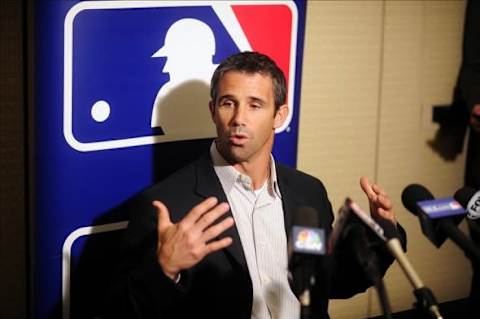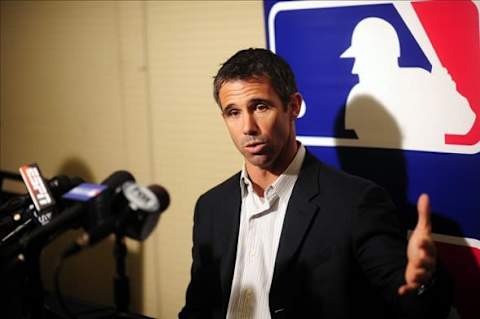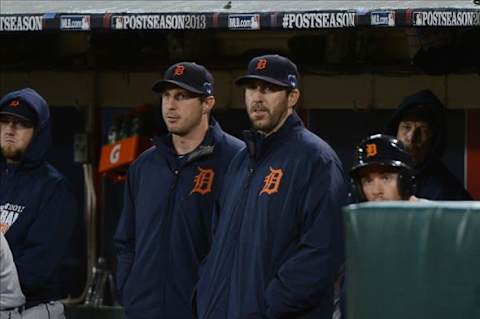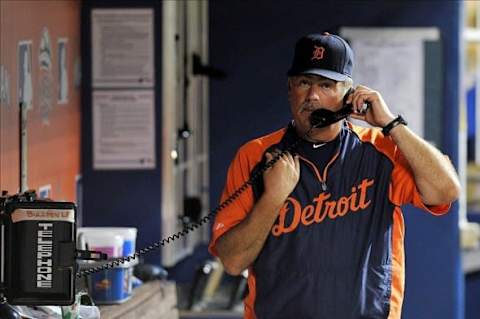Five Wishes for the Detroit Tigers in 2014


5. Detroit Tigers Fans Give Brad Ausmus A Chance
If you’ve followed the Detroit Tigers with even mild interest for the last year or two — and chances are if you’re reading this blog, you have — then you’re aware that it was impossible to go five minutes without someone, somewhere advocating for the team to fire Jim Leyland. Despite three straight appearances in the ALCS (and one World Series appearance), the aging skipper had lost the trust of much of the fan base.
Some of the criticism was justified and some of it wasn’t, but Tigers fans were (very nearly) as partisan as the United States Senate. There was the anti-Leyland crowd: when the team lost it was his fault and when they won it was always despite the manager. And there was the pro-Leyland crowd: he’d brought darn near as much success in eight years as the team had seen in the 45 years previous. It had become a stalemate, and neither side was going to win much more ground.
But then Jim Leyland announced his retirement following the season, and both sides were mostly satisfied. One side that the successful manager was able to leave on his own terms, and one side that the old voice was finally yielding to a newer one.
Brad Ausmus was hired to take over: a young-gun hopefully capable at looking at the post with fresh eyes, but also a former player, a gritty catcher who will respect the game. Hopefully the partisanship can end here. The Tigers are still built to win — and they’ll surely be the favorites again in the central — but Ausmus needs to be afforded the luxury of making a few mistakes along the way. The Ausmus hire was a hire for now — Mike Ilitch and Dave Dombrowski won’t be giving up on a chance for a ring — but it’s also a hire for the future. For an organization who will have to figure out how to contend while transitioning from a Miguel Cabrera–Justin Verlander led team to one led by (perhaps) players currently unknown.
The expectations for the new manager will be high, but they also must be realistic. Ausmus will be expected to win with the club right away, but he can’t be expected to be perfect. In order for Ausmus to lead the Tigers to long-term success, he must be afforded the luxury of short-term failure.
But this leads us to wish #4…

4. Brad Ausmus Embraces The “New School” Approach
No manager can be expected to be perfect – many of the decisions need to be made in the heat of the moment, and even with piles of after-the-fact data it’s sometimes hard to determine what the optimal move ought to have been – but this doesn’t mean managers should just make the same tired moves that have been made for the last 100 years without applying critical thought to the tactical side of the job.
Jim Leyland was a staunch “old school” guy, and no one would argue that he was an above-average tactician. He excelled at managing the clubhouse, but his on-field moves were never going to be revolutionary. He didn’t like to shift much. He like defined roles for his bullpen. He didn’t like to mix up the batting order, even when players had a day off. He didn’t use his backup catcher as a pinch hitter. He wasn’t afraid to bunt if he thought the situation called for it. Leyland rarely made the repeated gosh-awful moves that drag down win expectancy (like over-use of the sacrifice bunt), but neither did he like to go outside the box and open himself up to second guessing. He lived in that safe middle ground called “tradition”. Ausmus, hopefully, will be willing to buck tradition for the sake of optimal strategy.
This isn’t to say, however, that he should manage to turn the game into something unrecognizable, but in this day and age, the manager’s job is to take in all sorts of new (and old) information to optimize the team’s chances to win every night. The “new school” approach isn’t about having all the right answers, it’s about listening to everyone – the scouts and the data guys – when formulating strategies, deciding when (or if) to bunt, and figuring out how your bullpen best matches up with the opposing lineup.
The Tigers have shown this offseason that they won’t be able to sustain an ever-expanding payroll. There’s a limit to the funds, and we might be just about there. That means extra wins will need to be squeezed out by optimal lineups, sound bullpen usage, and the like. Hopefully Ausmus will embrace this sort of open minded approach and eschew the old school “this is the way it’s always been done” mindset.

3. The Starting Rotation Stays Healthy
The Tigers were very fortunate in this regard in 2013. They only used six starting pitchers to get through the season, with only six starts being made by the sixth guy (and one start coming out of luxury, not necessity, in the final week of the season). Other than basically a month missed by Anibal Sanchez due to elbow soreness, the Tigers’ starters were healthy and durable.
No team can expect to get through a season unscathed as far as the starting rotation is concerned – we’re simply talking about too many innings for something not to go wrong – but the 2014 Tigers look less able to afford a significant injury than the 2013 Tigers were. If you’re an optimistic type, you could make a reasonable argument for Drew Smyly making up for much of Doug Fister’s production as a starting pitcher, but he can’t also make up for the lack of depth caused by his own movement from the bullpen to the rotation.
The Tigers didn’t elect to do this for the few starts they needed, but if a significant injury occurred (particularly early on), they could have stretched out Smyly rather quickly to serve as an instant (and legitimate) major league fill-in. And I think that’s my biggest beef with the Fister trade. It’s no so much the marginal decline in overall ability of the starting five (as I said, one could argue that it won’t be all that much different), it’s in the lack of depth (both bullpen and rotation) that it also caused.
It would never be easy to lose someone like Max Scherzer in April, but right now the Tigers are looking at one of Kyle Lobstein, Duane Below, Jose Alvarez, or Robbie Ray as the long-term fill-in should that happen. It’s not immediately clear that any of those four could manage to hold their ERA much below 5.00 for a season. Perhaps someone like Lobstein or Ray could be surprisingly good in 2014, but I wouldn’t like to see either pitcher have to throw 150 innings in a pennant race.
The Tigers are still good enough to win the division even if they should suffer an injury to one of their top three starters, but an already thin margin for error and a questionable bullpen would make it far from a sure thing.

2. Defense Makes Up For Offense
Poor postseason aside, Prince Fielder was still a formidable offensive threat last season, and the Tigers are going to miss having him in the lineup. But just as much as Fielder, they’re going to miss the offensive contributions of Omar Infante and Jhonny Peralta, who were among the best hitters at their respective positions a season ago.
The loss of Infante will be made up for by the addition of Ian Kinsler, but the Tigers are going to have to hope that the flashy glove of Jose Iglesias can make up for his weak bat, that Nick Castellanos can figure out a way to improve on the defensive (in)abilities of Miguel Cabrera, and that Cabrera can prove to be a better first baseman than Fielder.
It’s not entirely impossible that the 2014 Tigers could outhit the 2013 Tigers — Alex Avila could put together a full season like his second half, Andy Dirks could rebound, Nick Castellanos could be the bat we hoped he’d be, and Austin Jackson could cut down on the strikeouts and find more ways to get on base, but the odds are long that all of those things come together in the best case scenario.
The more likely scenario (though still not a sure-thing) is that the Tigers show an improved defense (particularly on the infield) to make up for the (almost) inevitable decline in offense. Detroit hasn’t had a particularly balanced team in a number of years, typically forgoing defensive prowess for thundering sluggers. The 2014 club still appears to favor offense, but they have a chance to be a more balanced club than we’ve seen the last couple of years.
Offense is fun — it probably puts more butts in the seats than sound defense does — but the hope for 2014 is that the gloves can save a few more runs than they did in the past, and hopefully make for some of the runs that were lost this offseason.

1. Jeff Jones Works His Magic On The Bullpen
Jeff Jones might not be an actual magician, but what we’ve learned so far in his tenure as the pitching coach of the Detroit Tigers is that he’s certainly not NOT a magician. It’s impossible to say what exactly he should get credit for, but under his tutelage Max Scherzer turned into a Cy Young Award pitcher, Rick Porcello was finally able to ratchet up his strikeout rate, Anibal Sanchez was able to lead the league in ERA, and Doug Fister went from an unknown to a household name. All of those pitchers possessed certain skills and potential before Jones laid hands on them, but what actually happened was real, measurable improvement for each of them.
Maybe that was all coincidence, but maybe it wasn’t.
If it wasn’t all one giant coincidence, the Tigers need some of that very same Jeff Jones magic to be sprinkled around the bullpen, the only real question mark on the team. Besides Joe Nathan, the Tigers don’t really have a single sure-fire reliable bullpen arm on the roster, but they do have several players with potential. Joba Chamberlain still apparently throws hard. Al Alburquerque has one of the most devastating sliders you’ve ever seen. Phil Coke has flashed plus stuff from the left side. Bruce Rondon throw pure gas.
But what the Tigers need is for two or three of those pitchers to turn into solid, reliable seventh and eighth inning options in front of Nathan. What they need is for all the potential to turn into real, measurable improvement. If Chamberlain can return to pre-2011 form, if Alburquerque can find some semblance of command, if Phil Coke can even just get lefties out, and if Bruce Rondon can take one small step forward, then the bullpen could actually turn into a relative strength.
That’s a lot of ifs to hope for, but if Jones can mold to middle relief corps into even reasonable options, then the Tigers would transform into a team without an exploitable weakness.